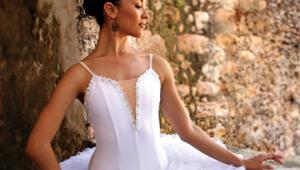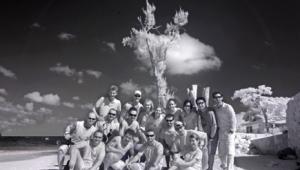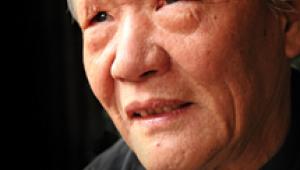Master Class
Why Black And White? In A Word—DRAMA! Page 2
Evoking Another Era
A Victorian-style living room and a traditional wedding gown both called for
the removal of color in this portrait. For sure, color photography wasn't
available in this era of time. Either black and white or sepia are much more
in-tune with the theme of this bridal portrait, don't you think?
 |
Fill Flash & Black And White
Sometimes black and white fools me. Occasionally, pictures that I meant to be
in color turned out just as good in black and white.
 |
I had always loved this portrait in color. Now I like it just as much without
the color.
The sky in the original went a real dark blue, a golden yellow close to his
body. The contrast of the white pants made it beautiful. The sun was setting
behind him. I exposed for bright sunshine, 1/125 sec at f/16. His face and body
would have been in silhouette had I not used a Quantum flash at almost right
angles, bringing the exposure on him up to the f/16, too. You can see the angle
from which the light came by the definition of his body and the shadows on his
face.
I tried the red channel, but I got a lot of noise in the sky. The blue channel
seemed to give me more of what I wanted when I worked with it in Levels.
Infrared--The Only Way To Go Is Black And White!
Although an infrared effect can be created in color, I much prefer the black
and white tones that are created with digital cameras that have been converted
(see www.irdigital.net
for info on camera conversion). Skin tones in infrared digital are superb with
just a little tweaking in Levels. Direct early-morning sun on their faces gave
me the contrast I needed to make this portrait jump in black and white. Again,
I toned the busy background down slightly with Tapp's "cookie-cutter"
lighting. That is an adjustment layer in Curves that's been painted out
in the center to diminish the possible distraction of the background.
 |
Black And White For Newspapers
This past summer I got a call to do some publicity shots for a musical show,
News in Review. I wasn't quite sure how I was going to do it when I went
on location. It seemed to me that the only way to do it was to use the stage
lights. I did a custom white balance and everything appeared to be working just
fine. They wanted a whole series of pictures covering the various acts in the
show. While doing a run-through the director paused them at strategic moments
for photographs.
The color shots were great, but they really wanted black and white glossies
for newspaper reproduction. Either that, or just the files on a CD. I was able
to do black and whites okay, but a new method that Tapp taught me in our recent
class together seemed to work better than anything that I had previously done
to convert color to black and white.
 |
What I learned was to pull up the file on my computer and change the Mode
to Lab Color. Then, when looking at the Channels in that mode there is always
a Lightness channel. It's all in black and white. If I want to lighten
or darken anything I can work in that Lightness channel and then bring it back
to full color by clicking on Lab again. I can do wonders in that channel. Then,
when it's all over the colors aren't affected at all. It's
fantastic.
So, that's where I went with this picture of the performers. Since the
lighting was by the stage lights, some of their arms were too bright, while
others were too dark. Very little detail in their black clothing. I selected
several areas to make lighter or darker and did it there in the Lightness channel.
I also went Image/Adjust/Shadow and Highlight to bring out detail in their black
clothing.
When I finished working in the Lightness channel, I liked what it looked like
so much I never took it back to the full Lab mode to get the color back into
the picture. Instead, I changed it to Grayscale, getting rid of all the color
layers and then finally brought it back to RGB. The detail throughout the image
is incredible! I've never had such wonderful detail all the way down into
their black clothing!
What a great way to create black and white images from color! Black and white
glossies for newspaper reproductions will never be the same if photographers
do what I did.
- Log in or register to post comments

















































